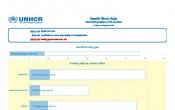Afghanistan
Operation: Afghanistan
Location
{"longitude":65,"latitude":34,"zoom_level":0}
Latest update of camps and office locations 13 Jan 2016. By clicking on the icons on the map, additional information is displayed.
Key Figures
| 229 | Number of personnel (international and national) |
| 8 | Number of offices |
| 137.7 million | Overall funding requirements in USD (ExCom-approved 2016 budget) |
| 172,000 | Number of people of concern receiving cash grants (returnees) |
| 100% | Percentage of people of concern registered on an individual basis (refugees) |
| 146,500 | Number of households receiving core relief items (IDPs) |
Latest Updates
Last Updated August 2015
People of Concern
33%
Increase in
2015
2015
| 2015 | 1,767,291 |
| 2014 | 1,324,996 |
| 2013 | 985,197 |

[["Refugees",237069],["Refugee-like situation",20485],["Asylum-seekers",82],["IDPs",1174306],["Returned IDPs",123653],["Returned refugees",61379],["Others of concern",150317]]
Loading ...
Budgets and Expenditure for Afghanistan
< Back
2015
{"categories":[2012,2013,2014,2015,2016],"budget":[139.66510505,131.37522619,151.97085579,150.64388639,137.73386476],"expenditure":[87.36351513,63.92581611,64.25946191,70.35477096,null]}
{"categories":[2012,2013,2014,2015,2016],"p1":[43.42574716,38.23178704,58.44455712,66.83857405,62.07538491],"p2":[null,null,null,null,null],"p3":[77.61677607,65.79076549,60.08470407,56.92509855,51.82562762],"p4":[18.62258182,27.35267366,33.4415946,26.88021379,23.83285223]}
{"categories":[2012,2013,2014,2015,2016],"p1":[33.26558041,18.32759334,25.27108431,42.22418797,null],"p2":[null,null,null,null,null],"p3":[40.66408206,30.54190771,24.42136004,17.78314669,null],"p4":[13.43385266,15.05631506,14.56701756,10.3474363,null]}
Loading ...
CHOOSE A YEAR
- 2014
- 2015
- 2016
Working environment
It is anticipated that the newly-formed national unity Government will demonstrate commitment to creating an enabling environment for sustainable returns. The withdrawal of international security forces, as well as a complex economic transition are, however, likely to affect peace, security and development in Afghanistan. Humanitarian needs are not expected to diminish in 2015. Support and assistance from the international community will be essential to ensure a transition towards more stable development.The Solutions Strategy for Afghan Refugees (SSAR) remains the main policy framework for sustainable reintegration of those returning to Afghanistan. The National Steering Committee established in 2014 aims to facilitate the implementation and monitoring of the SSAR’s initiatives.
Many returnees have migrated to towns and cities, contributing to the country’s rapid urbanization. As rising poverty and unemployment in urban centres prevent them from reintegrating into society, many will need basic assistance.
Currently, there is no national asylum and refugee legislation in Afghanistan, so UNHCR is conducting refugee status determination (RSD). A draft national refugee and asylum law, prepared with UNHCR assistance, is awaiting inclusion in the 2015 legislation agenda.
The Government of Afghanistan respects the principle of non-refoulement and host communities have provided generous support; however, refugees face protection concerns related to the volatile security situation, and difficulties in accessing basic services.
Insurgency continues to spread from southern Afghanistan to large areas of the north and centre and is likely to remain a threat to stability in 2015. While violence may displace more people, insecurity is likely to continue restricting humanitarian access. Economic insecurity and the Government’s limited capacity to provide basic services are also challenges.
Needs and strategies
The SSAR remains the regional policy framework and aims to enhance the reintegration of refugee returnees by strengthening partnerships with development actors and advocating sustainable solutions for people of concern.Shelter remains the most pressing need for returnees, IDPs and people in a refugee-like situation, particularly in large cities, where land issues are prevalent. Another critical issue throughout Afghanistan is a lack of both drinking and irrigation water.
Scarce resources and limited basic infrastructure are linked to poor employment opportunities, which also affect the sustainable reintegration of Afghan returnees.
Women and girls face challenges in attending school, obtaining identification cards, or participating in local decision-making structures. Standard referral and response mechanisms for survivors of violence do not yet exist in Afghanistan. In rural areas, survivors of sexual and gender-based violence (SGBV) lack psychological and social support. UNHCR has a five-year plan to prevent SGBV in Afghanistan and promote women’s empowerment.




